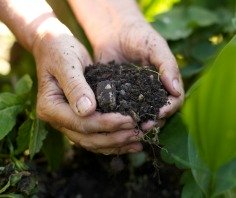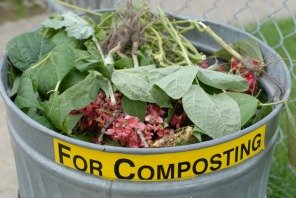Organic Gardening
Organic gardening is the choice of many vegetable gardeners. In fact, since the end of World War II organic gardening has gained in popularity to the point where it has become the number one preference for growing vegetables.
As more and more beginner gardeners turn to organic vegetable gardening as a recreational hobby, the most common question asked is "how do I go about growing vegetables?"
It is a simple enough question to answer, but depending who you ask can make all the difference in your approach to vegetable gardening.
For any vegetable to grow healthy and strong the soil must be rich in nutrients, and this is where the beginner gardening enthusiast must choose whether to use an organic gardening or synthetic chemical approach for growing vegetables.
Both methods will get the job done, but this is where the similarity between both gardening methods ends.
Before we talk about organic gardening, here is a quick note for week-end gardeners who don't have a whole lot of time to devote to their gardening hobby. If this is your case, and you still want to enjoy growing great vegetables, read our article about other methods to grow a vegetable garden other than organic gardening, which I've included in our vegetable fertilizer section of our web site.
You can read the whole article or scroll down to the title heading "Chemical Fertilizer."
And now for the rest of our beginner gardeners, who prefer organic gardening as a method of choice, let's begin.
What is meant by Organic Gardening?

Well, to say it as simply as possible it is applying Mother Nature in the vegetable garden. To expand this statement just a little we can say using fertilizers consisting only of naturally occurring plant and animal material with no additive man/woman-made chemicals or pesticides.
So there you have it, organic gardeners adhere to strict guidelines
when growing vegetables. To some beginner gardeners this approach may seem like a lot of work and is it really worth it? The answer is quite simple... Yes! Not only will you're vegetable plants remain healthy but more importantly, so will you.
Here again is our definition of organic gardening, it's worth repeating. "The use of fertilizers consisting only of naturally occurring plant and animal material with no additive man/woman-made chemicals or pesticides." This statement seems to hold true from several studies from the scientific community that growing vegetables organically provides more beneficial nutrients like iron, magnesium, phosphorous, and vitamins, while reducing exposure to potentially harmful chemicals and pesticides.
The organic approach to vegetable gardening first begins with a good fertile soil to support the growth of your vegetable plants. Therefore, it is important to know if your soil has all the necessary nutrients to support the growth of a healthy crop. Why? Because all vegetable plants need the correct pH (acidity and alkalinity) level which controls how well they utilize the nutrients in your soil. Different vegetable plants have a different pH preference (know what you vegetable plants need when you buy them) so it is important to know the pH level of your soil. One of the simplest ways to check the condition of your soil is to use a pH soil test kit. They are quite reasonable in price and can be found at most garden centers.
Organic Gardening Begins with Healthy Soil

Now you wouldn't have known this if you didn't test your soil before you planted your vegetable plants and aren't you glad you did. Fortunately a good pH soil tester will offer suggestions on how to correct your soils pH problem, so make sure
before you buy your soil tester you check for this option. I recommend you also test your soil periodically throughout the growing season and in the fall to prepare if necessary your vegetable bed for next spring's planting. To learn how to use a soil tester, read our article vegetable fertilizer.
So, how is your soil? Do you have the green light to start planting vegetables? For those of you who aren't smiling with you soil testing result, you need to correct the problem.
Soil pH
The soil pH (acidity/alkaline) is important because it affects the availability of nutrients in the soil. After taking a soil test reading, you now know whether your soil is within acceptable range, too acidic, or too alkaline.
If your soil test indicates your soil is too alkaline, you can lower you soil's pH by making it more acidic.
Acidifying fertilizers include sphagnum peat, ammonium nitrate, iron sulfate, ammonium sulfate, aluminum sulfate, and organic mulches. Make sure when you purchase your fertilizer, you read the label on the bag to make sure it is an acidifying fertilizer. Oh! One more thing, before you rush out into the garden to add the fertilizer, take a moment and read the manufactures instructions on use.
If your soil is too acidic, you can lower soil acidity by adding limestone which contains calcium and magnesium. Before you buy, check at any organic gardening outlet for this product manufactured in a pelletize form. It is not as dusty as powdered lime and your nostrils and your clothing will thank you. Again, read the manufactures instructions before use.
Organic Gardening Involves The Right Nutrients in The Soil
As we said earlier, successful organic gardening begins with healthy soil. Your vegetable plants need Nitrogen to encourage leaf growth, Phosphorus to encourage roots and flowers, and Potassium to encourage vitality
and health of your plants.
There are many organic fertilizers available on the market you can purchase to amend your soil if it is lacking proper nutrients, and most are available processed and packaged.
Source of Nutrients:
- Nitrogen
Fish emulsion, livestock manure, blood meal, bat guano, cottonseed meal, and kelp meal. - Phosphorus
Rock phosphate, super phosphate, and bone meal. - Potassium
Wood ashes, sulfate of potash, granite meal, greensand, shrimp shell meal, and seabird guano. - Calcium
Eggshells, bone meal, oyster shells, limestone, chelated calcium, and wood ashes. - Boron
Chelated boron, borax. - Copper
Chelated copper. - Magnesium
Dolomitic limestone, chelated magnesium, and Epsom salts. - Sulfur
Sulfur, iron sulfate, solubor, and zinc sulfate. - Zinc
Zinc sulfate, iron sulfate, chelated zinc iron, and chelated iron.
Organic Gardeners Nourish the Soil
If you haven't guessed it already and I'm sure most of you have, the approach to organic gardening is all about building soil within the guideline of Mother Nature. As I mentioned in other articles on vegetable gardening, "if you feed the soil, the soil feeds your plants." But there is still more we can do to make the soil all it can be. We need to add organic matter to the soil to feed the earthworms and other living organisms in the soil that break it down into the beneficial nutrients plants need.
Organic Compost


Ah! Black gold. I can think of no better way to amend your garden soil than to add organic compost. That is... Home-made compost. It is easy to do and everyone has access to the ingredients to produce these highly enriched nutrients for your vegetable garden.
Making your own compost has been around I guess, ever since farmers first planted vegetables. All you need is kitchen scraps (but not all), grass clippings, and other plant material easily found in your garden such as dried leaves and a little garden soil. Oh yes! And a place in your garden to create your compost pile.
To learn how to make your own compost we have devoted an article
Making Compost which has all the information you need to make your very own black gold.
Why do I keep saying "black gold?" Because first of all, it is Mother Nature at work and second, ready-to-use natural organic compost will give your soil all the necessary nutrients your vegetable plants need to grow strong and wonderfully healthy.
Organic Gardening Means Amending The Soil
Now that we have made organic compost, it's time to add it to the soil, that is to say amending, the soil. To do so, first you must loosen the soil for easy and thorough mixing of your compost. However, if you recently had rain and your soil is wet and heavy, let the soil dry for a few days to make the task of turning the soil much easier. On the other hand, if your soil is extremely dry, a thorough watering a few days ahead of time will make your task much easier. Vegetable gardening should be fun not heavy duty labor, so remember these suggestions prior to adding your compost. As my vegetable garden is not that large, I prefer to use a raised bed garden, I have greater control over my vegetables and less toil than traditional gardening. Whether you plant your vegetables in a raised bed or plant directly in the ground, the process of amending your soil is the same. That said; let's continue with the mix of our compost.
Spread your compost evenly over your vegetable garden area and then using a shovel or pitch fork, work the compost into the soil to a depth of approximately 12 inches. If you have a large garden area too laborious for the use of a shovel or pitch fork, you can rent a rototiller from Lowe's or Home Depot or from any other garden supplier that will get the job done. When mixing of your compost is completed, use a garden rake to level of your garden area. Voila! Your organic soil is now replenished for the gardening season.
I know if you're like me, you won't be disappointed.
To learn more about organic gardening, I have added a link to the University of Missouri organic gardening extension.
Before you leave me why not drop into My Gift Shop for a peek and see if you find something of interest for you, family, or friends.
Until next time,
Happy Gardening
Copyright © 2008-2019 All rights reserved.
